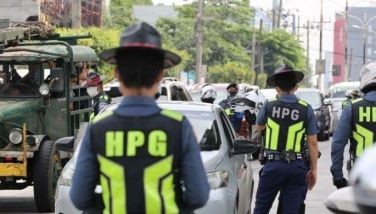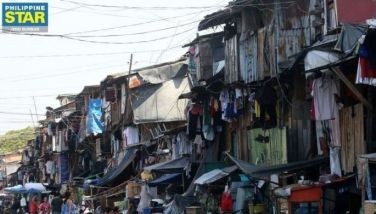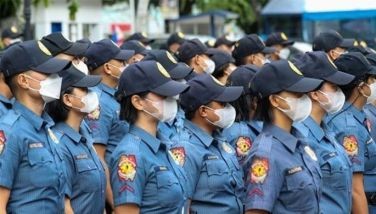Kidapawan tragedy: Spotlight on climate change and local governance
April 18, 2016 | 5:47am
MANILA, Philippines – Two weeks before the violent encounter between the police and the farmers in Kidapawan happened, Cotabato Gov.Emmylou Taliño-Mendoza delivered her State of the Province Address where she proudly said that the province is “surviving the drought” brought by El Niño.
Local daily Sunstar reported that Mendoza described 2016 as a “breakthrough year” for the province because they were able to respond to the challenge of El Niño, which started in 2015.
“After being hit, we bounced back," she said.
The lives that were lost in the Kidapawan encounter between the farmers and the police tell a different story.
On April 1, at least five people who were part of a protest demanding drought assistance from the provincial government were shot dead. Tension erupted after police tried to drive away some 5,000 farmers who held a blockade starting on March 29 to demand 15,000 sacks of rice from the provincial government. Aside from the five people who died, another 116 were injured both from the side of the police and those who joined the blockade.
The farmers sought help from the provincial government after an almost year-long El Niño caused a massive dry spell, destroying their sources of income and consequently driving them and their families to hunger. Data from the Department of Agriculture showed that El Niño has affected production in some 15,706 hectares of land in North Cotabato, incurring damages worth P405.73 million.
Mendoza is now under fire for failing to urgently address the needs of the farmers and for failing to stop the protest from turning deadly. But she is not alone.
In 2013, Mayor Alfred Romualdez in Tacloban saw the deaths of at least 2,000 people under his term due to Typhoon Yolanda (international name: Haiyan), the strongest storm to make landfall in recent history. The local government unit (LGU) prepared for the disaster, but lapses in communicating the scale and magnitude of the effects of the super typhoon to the people proved costly.
Politics also entered the picture as Romualdez and then Interior and Local Government Secretary Manuel ‘Mar’ Roxas II engaged each other in a blame game over the catastrophe.
Romualdez’s wife Cristina, an incumbent councilor, is seeking to replace her husband as mayor.
His cousin, Martin, on the other hand, is seeking a Senate seat and has been using his relief operations for the victims Yolanda in his campaign ad, much to the consternation of students from Leyte.
There are another set of officials from 20 provinces most vulnerable to the effects of climate change that can face problems of flooding, displacement, loss of income and, as what the Kidapawan incident showed, deadly conflict.
The question is – how ready are they to handle these?
Part of mandate
The tragedy in Kidapawan came a week after jingles and proclamation rallies signaled the start of the campaign period for candidates gunning for local posts.
The two events – contrasting in mood but complementary in message – raise the reality for the voting public that natural disasters, extreme weather events and the causes of climate change constitute a critical election issue.
Mendoza is running unopposed in the upcoming elections on May 9 – and hence will remain governor for another three years, but the dry spell caused by El Niño will not be the last disaster she could face.
The next three years of her term will be a period of facing accountability for her constituents who can experience hunger, loss of employment, sickness and other potential effects of climate change.
The same goes for other LGUs which are at the frontlines of disasters and other impacts of climate change; since they are the first to experience the problem, they should also be, with ample help from the national government, the first to provide solutions.
Grizelda Mayo-Anda, founder of the Environmental Legal Assistance Center and who has trained LGUs on mitigating climate change, said that Philippine laws are clear about the duties of LGU officials in addressing climate change and disaster risks.
“We have the Climate Change law and the Disaster Risk Reduction and Management (DRRM) law. These two laws provide that LGUs are supposed to formulate climate change action plans (LCCAP) and local DRRM plans,” she said.
Local climate change action plans must contain the LGU’s programs and strategies for mitigation and adaptation. Mitigation refers to the reduction of greenhouse gas emissions which cause climate change, while adaptation includes steps to be taken to adjust to the effects of climate change. These include switching to more drought-resistant crops, elevating dikes, and purchasing flood insurance.
DRRM plans, on the other hand, cover programs for disaster prevention, mitigation, preparedness, response, recovery, and rehabilitation.
These plans address the links between climate change mitigation, adaptation, and disaster risk reduction and management. Climate change, which is caused by rising greenhouse gas emissions, is expected to intensify extreme weather events such as El Niño and bring more disasters that have the force of Yolanda, or even stronger. LGUs must then be able to address these links when planning their programs.
Data from the Department of the Interior and Local Government showed, however, that out of 782 provinces, cities and municipalities that have been trained in formulating the LCCAP, there are only 160 LGUs (1 province, 24 cities, and 135 municipalities) that have actually developed their respective local climate change action plans as of December 2015.
But it’s not just about the numbers – the quality of the plans itself is under question.
“Some local DRRM plans are “copy-paste,” Ivy Panganiban from the Caucus of Code of Development-NGO said. Panganiban, who earlier this year reviewed the government’s efforts to meet its DRRM targets under the 2011-2016 Philippine Development Plan, said the local plans “were not based on risk assessment.”
Reactive measures are not enough
Aaron Pedrosa, an environmental lawyer, pointed out that LGU officials are responsible not only for handling disasters and for preparing their constituencies for the effects of climate change, they also have the responsibility to address the root causes of climate change itself.
This is part of their mandate under the LGU code. “We ask them to be consistent with what is provided of them under the LGU code na general welfare powers – that is to protect and advance a balance and healthful ecology. Kasama yan sa kanilang kapangyarihan,” the secretary-general of the Sanlakas party-list group said.
He said this should remind LGUs that they have the power to approve or reject projects that could contribute to climate change itself, such as the establishment of coal-fired power plants (CFPPs). CFPPs emit greenhouse gases that do not only pollute the air and cause climate change, they also have impacts on the health of communities.
The LGUs in Palawan and Subic opposed the construction of coal-fired power plants in their areas. The municipal councils in Narra and Aborlan in Palawan issued separate resolutions opposing the establishment of a DMCI coal power plant in their respective areas.
In Subic, the city council passed two resolutions in 2013 rejecting the establishment of a 600-megawatt coal-fired power plant of Redondo Peninsula Energy Inc.
Archbishop Ramon Arguelles, who led the campaign against CFPPs in Batangas, said the LGUs must be more mindful of their role in climate change mitigation. “The LGUs are at the frontline of this endeavor. They must not support coal plants, which contribute to climate change. Climate change affects the welfare of the community and harms the poorest.”
Money is there, but…
LGUs have access to resources for climate change adaptation and disaster risk reduction and management.
They are mandated to set aside five percent of their budget for their DRRM fund, 30 percent of which can be used as Quick Response Fund for relief and recovery efforts. The remaining 70 percent can be used for disaster preparedness initiatives such as capacity-building.
Prior to 2010, the DRRM fund, then known as the calamity fund, can only be used for rescue and relief operations or disaster response. The passage of the Philippine Disaster Risk and Reduction Management Act or Republic Act 10121 in 2010 changed this and LGUs were authorized to use their DRRM fund to also prepare for disasters.
LGUs do not get to truly maximize this improved allocation design of DRRM funds, however, as the fund distribution is still lopsided. It has been reported that the Commission on Audit assessed the use of DRRM funds after Typhoon Yolanda in 2013 and found out that there is an “imbalance between available resources and risk exposure,” which means provinces that are more disaster-prone do not necessarily get more funds for calamities.
There are some LGUs which also experienced confusion on how the DRRM funds can be used.
According to a report by The Daily Guardian, Iloilo realigned P3.4 million in unspent DRRM funds in 2010 to the allowances of judges, prosecutors, and other government agencies. COA disallowed it.
RA 10121 states that unspent funds must be put in a trust fund that can be tapped to minimize the effects of disasters by training LGU officials on DRRM or procuring necessary equipment.
COA has issued guidelines in 2012 on the use of DRRM funds to ensure its proper utilization.
LGUs can also seek calamity assistance from the national government. This budget can be released upon the approval of the president and with the recommendation of the National Disaster Risk Reduction Management Council (NDRRMC).
Other funds that can be accessed are the People’s Survival Fund (PSF) for climate change adaptation. One of the requirements in accessing the PSF is the local climate action plan. The CCC said that 39 proposals are now being assessed. Other proposals have been rejected outright though because they lacked audited financial statements, an executive order creating a project implementation unit for the PSF and even a work plan.
LGUs need community and national gov't
North Cotabato declared a state of calamity due to El Niño in January this year. By that time, affected lands covered 27,558 hectares while damage has reached P238 million.
The Department of Agriculture has also started cloud-seeding operations that month not only in North Cotabato but also in the provinces of Sultan Kudarat and Saranggani. The Philippine Daily Inquirer reported that the DA allotted P6 million for the cloud-seeding operations. The operations were stopped in March, however after clashes erupted between the military and members of the Jemaah Islamiyah terrorist group.
The Kidapawan City Council, on the other hand, declared a state of calamity in February. This allowed them to use part of their P4 million LDRRM fund to provide assistance to 11,000 families affected by El Niño. A month after, the city government implemented a food-for-work program where heads of families were paid with 15 kilos of rice if they worked on projects ranging from the cleanup of canals to the rat tail and anti-black bug campaign.
The assistance had not been adequate, however, and farmers trooped to the provincial government to demand more. In cases like this, Mayo-Anda said LGUs must go beyond just complying with the DRRM laws or releasing funds – it requires treating the community as partners in dealing with climate change.
“Another concern is on dealing with a disgruntled, suffering yet aggressive farmer community. Strategies for dialogue and other approaches should have been explored,” she said.dialogue and other approaches should have been explored,” she said.
“Local communities such as farmers must be part of the process so local officials are enlightened about the nature and extent of hardships faced as well as the urgent responses needed.”
Jonathan Ong, lead researcher of the study “Who’s Listening? Accountability to Affected People in the Haiyan Response,” said that the Kidapawan tragedy, just like Yolanda, also showed gaps and loopholes in the procedures undertaken by the national government and the LGUs in providing relief to victims of calamities.
Ong said that while the Kidapawan tragedy clearly showed that LGUs “don’t handle relief distribution very well,” the national government has also to revisit its procedures in providing relief assistance.
Comparing it to what happened in Yolanda, Ong said that the local officials not only in Tacloban but other areas affected by the typhoon then “were critical of national government protocols and complain of being overburdened by rules and regulation without [the] capacity to be truly flexible and adaptable to local concerns and issues.”
Hence, Ong said that LGUs and the national government must seriously work on revamping the existing aid system. “National and local government should recognize that their aid distribution procedures deal further indignities to the victims of [a] calamity. There needs to be an overhaul of the process that emphasizes flexibility and adaptability to local community concerns.”Ong said that LGUs and the national government must seriously work on revamping the existing aid system. “National and local government should recognize that their aid distribution procedures deal further indignities to the victims of [a] calamity. There needs to be an overhaul of the process that emphasizes flexibility and adaptability to local community concerns.”
(VERA Files is put out by veteran journalists taking a deeper look at current issues. Vera is Latin for “true.”)
BrandSpace Articles
<
>
Philstar
x
- Latest
- Trending
Trending
Latest
Trending
Latest
Recommended



























